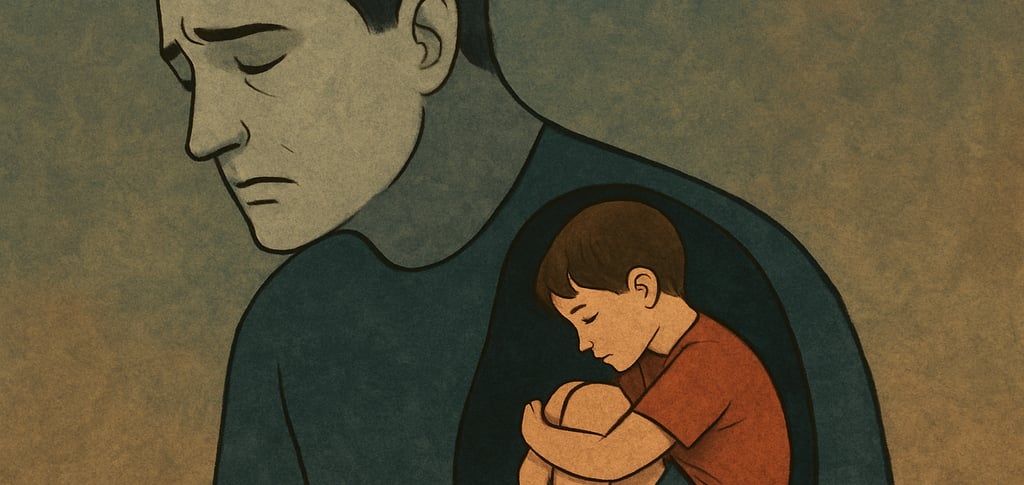Healing the Inner Child
In many Malaysian homes, emotions weren’t always spoken about—being “strong” often meant staying silent. It’s no one’s fault, but those quiet wounds can linger. Healing your inner child means offering yourself the care and understanding you’ve always deserved.


Have you ever felt like certain emotions or reactions seem to come from a younger version of yourself? That’s your inner child: the part of you that holds onto childhood experiences, both joyful and painful.
What is the Inner Child?
Your inner child is the part of you that carries memories, feelings, and experiences from your childhood. Unresolved pain from these formative years can shape how you handle stress, relationships, and self-worth as an adult. For example, if you grew up in a critical or neglectful environment, your inner child might still feel unworthy or unloved, influencing your adult behaviors.
In Malaysia, mental health conversations are becoming more common, but childhood trauma is still often overlooked or misunderstood. Many Malaysians were raised in environments where emotional expression was discouraged, discipline was harsh, or affection was conditional. In many Malaysian households, emotional needs were rarely talked about. What mattered was being obedient and achieving success. But emotional neglect, though invisible, can leave deep wounds. Recognizing this isn't about blaming our parents, but understanding what we missed so we can give it to ourselves now.
Why It Matters in Malaysia
A study conducted in Malaysia found that a significant number of adults have experienced at least one form of Adverse Childhood Experience (ACE), such as emotional neglect, domestic violence, or parental separation. These experiences can increase the risk of mental health issues like anxiety, depression, and low self-esteem in adulthood.
Cultural expectations and generational beliefs—such as “just toughen up” or “don’t talk back”—can make it harder for Malaysians to seek help or even acknowledge emotional wounds. But recognizing that your struggles may stem from unhealed parts of your inner child can be the turning point toward healing.
Signs Your Inner Child Might Be Wounded
Many people don’t realize that their current struggles may actually stem from wounds carried by their inner child. These wounds often show up in subtle but persistent ways throughout adulthood. You might notice you constantly struggle with low self-esteem, even if you're successful on the outside. Emotional overreactions in certain situations—like feeling deeply hurt by criticism—can also be a sign. Other common signs include a deep fear of rejection or abandonment, feeling unworthy of love or success, people-pleasing tendencies, difficulty setting boundaries, or a fear of expressing vulnerability. You may even feel like you always need to “earn” your worth. These patterns are often rooted in childhood experiences where emotional needs were unmet, minimized, or ignored. Recognizing these signs is the first step toward understanding, and healing the inner child within.
How Can You Heal?
Healing your inner child involves reconnecting with this part of yourself and addressing past wounds. Self-compassion and "reparenting" – offering the care and validation your younger self needed but didn’t receive – are crucial. Here are some steps to start:
Acknowledge the pain: Recognize how unresolved childhood experiences affect your life today.
Practice self-compassion: Be kind to yourself as you explore these emotions.
Seek support: Therapy or guided inner-child work can help you process these feelings safely.
Take the First Step
Healing your inner child isn’t about blaming the past but about reclaiming your emotional well-being today. Ready to start this journey? Our therapists at Mind Wave can guide you toward healing and growth; book an appointment today to start helping your inner child move forward.
References:
Bradshaw, J. (1990). Homecoming: Reclaiming and healing your inner child. Bantam Books
Sjöblom, M., Öhrling, K., Prellwitz, M., & Kostenius, C. (2016). Health throughout the lifespan: The phenomenon of the inner child reflected in events during childhood experienced by older persons. International journal of qualitative studies on health and well-being, 11, 31486.
Narang, S., & Jindal, R. (2016). Childhood trauma and its effects on mental health: A review. Journal of Mental Health and Human Behaviour, 21(2), 102–105.
Van der Kolk, B. A. (2014). The body keeps the score: Brain, mind, and body in the healing of trauma. Viking.


